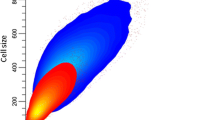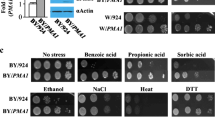Abstract
Yro2 and its paralogous protein Mrh1 of Saccharomyces cerevisiae have seven predicted transmembrane domains and predominantly localize to the plasma membrane. Their physiological functions and regulation of gene expression have not yet been elucidated in detail. We herein demonstrated that MRH1 was constitutively expressed, whereas the expression of YRO2 was induced by acetic acid stress and entering the stationary phase. Fluorescence microscopic analysis revealed that Mrh1 and Yro2 were distributed as small foci in the plasma membrane under acetic acid stress conditions. The null mutants of these genes (mrh1∆, yro2∆, and mrh1∆yro2∆) showed delayed growth and a decrease in the productivity of ethanol in the presence of acetic acid, indicating that Yro2 and Mrh1 are involved in tolerance to acetic acid stress.






Similar content being viewed by others
References
Bandhakavi S, Xie H, O’Callaghan B, Sakurai H, Kim DH, Griffin TJ (2008) Hsf1 activation inhibits rapamycin resistance and TOR signaling in yeast revealed by combined proteomic and genetic analysis. PLoS One 3:e1598. doi:10.1371/journal.pone.0001598
Byrne KP, Wolfe KH (2005) The yeast gene order browser: combining curated homology and syntenic context reveals gene fate in polyploid species. Genome Res 15:1456–1461
Carmelo V, Santos H, Sá-Correia I (1997) Effect of extracellular acidification on the activity of plasma membrane ATPase and on the cytosolic and vacuolar pH of Saccharomyces cerevisiae. Biochim Biophys Acta 1325:63–70
Chesson A, Gordon AJ, Lomax JA (1983) Substituent groups linked by alkali labile bonds to arabinose and xylose residues of legume grass and cereal straw walls and their fate during digestion by rumen microorganisms. J Sci Food Agric 34:1330–1340
Costa C, Henriques A, Pires C, Nunes J, Ohno M, Chibana H, Sá-Correia I, Teixeira MC (2013) The dual role of Candida glabrata drug: H+ antiporter CgAqr1 (ORF CAGL0J09944g) in antifungal drug and acetic acid resistance. Front Microbiol 4:170. doi:10.3389/fmicb.2013.00170
Fernandes AR, Mira NP, Vargas RC, Canelhas I, Sá-Correia I (2005) Saccharomyces cerevisiae adaptation to weak acids involves the transcription factor Haa1p and Haa1p-regulated genes. Biochem Biophys Res Commun 337:95–103
Garrido EO, Grant CM (2002) Role of thioredoxins in the response of Saccharomyces cerevisiae to oxidative stress induced by hydroperoxides. Mol Microbiol 43:993–1003
Graves T, Narendranath N, Dawson K, Power R (2006) Effect of pH and lactic or acetic acid on ethanol productivity by Saccharomyces cerevisiae in corn mash. J Ind Microbiol Biotechnol 33:469–474
Haitani Y, Tanaka K, Yamamoto M, Nakamura T, Ando A, Ogawa J, Shima J (2012) Identification of an acetate-tolerant strain of Saccharomyces cerevisiae and characterization by gene expression analysis. J Biosci Bioeng 144:648–651
Helle S, Cameron D, Lam J, White B, Duff S (2003) Effect of inhibitory compounds found in biomass hydrolysates on growth and xylose fermentation by a genetically engineered strain of S. cerevisiae. Enzyme Microb Technol 33:786–792
Hertogh BD, Carvajal E, Talla E, Dujon B, Baret P, Goffeau A (2002) Phylogenetic classification of transporters and other membrane proteins from Saccharomyces cerevisiae. Funct Integr Genomics 2:154–170
Inaba T, Watanabe D, Yoshiyama Y, Tanaka K, Ogawa J, Takagi H, Shimoi H, Shima J (2013) An organic acid-tolerant HAA1-overexpression mutant of an industrial bioethanol strain of Saccharomyces cerevisiae and its application to the production of bioethanol from sugarcane molasses. AMB Express 3:74. doi:10.1186/2191-0855-3-74
Iwaki A, Izawa S (2012) Acidic stress induces the formation of P-bodies, but not stress granules, with mild attenuation of bulk translation in Saccharomyces cerevisiae. Biochem J 446:225–233
Kahana JA, Schlenstedt G, Evanchuk DM, Geiser JR, Hoyt MA, Silver PA (1998) The yeast dynactin complex is involved in portioning the mitotic spindle between mother and daughter cells during anaphase B. Mol Biol Cell 9:1741–1756
Kamo K, Takabatake A, Inoue Y, Izawa S (2012) Temperature dependent N-glycosylation of plasma membrane heat shock protein Hsp30p in Saccharomyces cerevisiae. Biochem Biophys Res Commun 420:119–123
Kataja K, Satokari RM, Arvas M, Takkinen K, Söderlund H (2006) A highly sensitive and multiplexed method for focused transcript analysis. J Microbiol Methods 67:102–113
Kato K, Yamamoto Y, Izawa S (2011) Severe ethanol stress induces assembly of stress granules in Saccharomyces cerevisiae. Yeast 28:339–347
Keller G, Ray E, Brown PO, Winge DR (2001) Haa1, a protein homologous to the copper-regulated transcription factor Ace1, is a novel transcriptional activator. J Biol Chem 276:38697–38702
Kuge S, Jones N (1994) YAP1 dependent activation of TRX2 is essential for the response of Saccharomyces cerevisiae to oxidative stress by hydroperoxides. EMBO J 13:655–664
Lee YY, Iyer P, Torget RW (1999) Dilute-acid hydrolysis of lignocellulosic biomass. Adv Biochem Eng Biotechnol 65:93–115
Maiorella B, Blanch HW, Wilke CR (1983) By-product inhibition effects on ethanolic fermentation by Saccharomyces cerevisiae. Biotechnol Bioeng 25:103–121
Martinez-Pastor MT, Marchler G, Schüller C, Marchler-Bauer A, Ruis H, Estruch F (1996) The Saccharomyces cerevisiae zinc finger proteins Msn2p and Msn4p are required for transcriptional induction through the stress response element (STRE). EMBO J 15:2227–2235
Mira NP, Teixeira MC, Sá-Correia I (2010a) Adaptive response and tolerance to weak acid stress in Saccharomyces cerevisiae: a genome-wide view. OMICS J Integr Biol 14:525–540
Mira NP, Palma M, Guerreiro JF, Sá-Correia I (2010b) Genome-wide identification of Saccharomyces cerevisiae genes required for tolerance to acetic acid. Microb Cell Fact 9:79. doi:10.1186/1475-2859-9-79
Mira NP, Becker J, Sá-Correia I (2010c) Genomic expression program involving the Haa1p-regulon in Saccharomyces cerevisiae response to acetic acid. OMICS: J Integr Biol 14:587–601
Mira NP, Henriques SF, Keller G, Teixeira MC, Matos RG, Arraiano CM, Winge DR, Sá-Correia I (2011) Identification of a DNA-binding site for the transcription factor Haa1, required for Saccharomyces cerevisiae response to acetic acid stress. Nucleic Acids Res 39:6896–6907
Mira NP, Münsterkïtter M, Fμ D-V, Santos J, Palma M, Roque FC, Guerreiro JF, Rodrigues F, Sousa MJ, Leão C, Güldener U, Sá-Correia I (2014) The genome sequence of the highly acetic acid-tolerant Zygosaccharomyces bailii-derived interspecies hybrid strain ISA1307, isolated from a sparkling wine plant. DNA Res 21:299–313
Mollapour M, Piper PW (2007) Hog1 mitogen-activated protein kinase phosphorylation targets the yeast Fps1 aquaglyceroprotein for endocytosis, thereby rendering cells resistant to acetic acid. Mol Cell Biol 27:6446–6456
Morgan BA, Banks GR, Toone WM, Raitt DC, Kuge S, Johnston LH (1997) The Skn7 response regulator controls gene expression in the oxidative stress response of the budding yeast Saccharomyces cerevisiae. EMBO J 16:1035–1044
Moskvina E, Schuller C, Maurer CTC, Mager WH, Ruis H (1998) A search in the genome of Saccharomyces cerevisiae for genes regulated via stress response elements. Yeast 14:1041–1050
Narendranath NV, Thomas KC, Ingledew WM (2001a) Effects of acetic acid and lactic acid on the growth of Saccharomyces cerevisiae in a minimal medium. J Ind Microbiol Biotechnol 26:171–177
Narendranath NV, Thomas KC, Ingledew WM (2001b) Acetic acid and lactic acid inhibition of growth of Saccharomyces cerevisiae by different mechanisms. J Am Soc Brew Chem 59:187–194
Niu W, Li Z, Zhan W, Iyer VR, Marcotte EM (2008) Mechanisms of cell cycle control revealed by a systematic and quantitative overexpression screen in S. cerevisiae. PLoS Genet 4:e1000120. doi:10.1371/journal.pgen.1000120
Palmqvist E, Hahn-Hägerdal B (2000) Fermentation of lignocellulosic hydrolysates. I: inhibition and detoxification. Bioresour Technol 74:17–24
Pampulha MA, Loureiro-Dias MC (2000) Energetics of the effect of acetic acid on growth of Saccharomyces cerevisiae. FEMS Microbiol Lett 181:69–72
Phowchinda O, Délia-Dupuy ML, Strehaiano P (1995) Effects of acetic acid on growth and fermentative activity of Saccharomyces cerevsiae. Biotechnol Lett 17:237–242
Schmitt AP, McEntee K (1996) Msn2p, a zinc finger DNA-binding protein, is the transcriptional activator of the multistress response in Saccharomyces cerevisiae. Proc Natl Acad Sci USA 93:5777–5782
Schmitt ME, Brown TA, Trumpower BL (1990) A rapid and simple method for preparation of RNA from Saccharomyces cerevisiae. Nucleic Acids Res 18:3091–3092
Sikorski RS, Hieter P (1989) A system of shuttle vectors and yeast host strains designed for efficient manipulation of DNA in Saccharomyces cerevisiae. Gene 122:19–27
Sopko R, Huang D, Preston N, Chua G, Papp B, Kafadar K, Snyder M, Oliver SG, Cyert M, Hughes TR, Boone C, Andrews B (2006) Mapping pathways and phenotypes by systematic gene overexpression. Mol Cell 21:319–330
Stratford M, Steels H, Nebe-von-Caron G, Novodvorska M, Hayer K, Archer DB (2013) Extreme resistance to weak-acid preservatives in the spoilage yeast Zygosaccharomyces bailii. Int J Food Microbiol 166:126–134
Sugiyama K, Kawamura A, Izawa S, Inoue Y (2000) Role of glutathione in heat-shock-induced cell death of Saccharomyces cerevisiae. Biochem J 352:71–78
Takahashi T, Satake S, Hirose K, Hwang GH, Naganuma A (2011) A screening for essential cell growth-related genes involved in arsenite toxicity in Saccharomyces cerevisiae. J Toxicol Sci 36:859–861
Tanaka K, Ishii Y, Ogawa J, Shima J (2012) Enhancement of acetic acid tolerance in Saccharomyces cerevisiae by overexpression of the HAA1 gene, encoding a transcriptional activator. Appl Environ Microbiol 78:8161–8163
van Maris AJ, Abbott DA, Bellissimi E, van den Brink J, Kuyper M, Luttik MA, Wisselink HW, Scheffers WA, van Dijken JP, Pronk JT (2006) Alcoholic fermentation of carbon sources in biomass hydrolysates by Saccharomyces cerevisiae: current status. Antonie Van Leeuwenhoek 90:391–418
Viela-Moura A, Schuller D, Mendes A, Silva RD, Chaves SR, Sousa MJ, Côrte-Real M (2011) The impact of acetate metabolism on yeast fermentative performance and wine quality: reduction of volatile acidity of grape musts and wines. Appl Microbiol Biotechnol 89:271–280
Wu WS, Li WH (2008) Identifying gene regulatory modules of heat shock response in yeast. BMC Genomics 9:439. doi:10.1186/1471-2164-9-439
Wu K, Dawe JH, Aris JP (2000) Expression and subcellular localization of a membrane protein related to Hsp30p in Saccharomyces cerevisiae. Biochim Biophys Acta 1463:477–482
Yoshikawa K, Tanaka T, Ida Y, Furusawa C, Hirasawa T, Shimizu H (2011) Comprehensive phenotypic analysis of single-gene deletion and overexpression strains of Saccharomyces cerevisiae. Yeast 28:349–361
Acknowledgments
We are grateful to Dr. D. Watanabe (Nara Inst. Sci. Technol.) for valuable discussion. This study was supported by a grant from the Japanese Ministry of Education, Culture, Sports, Science and Technology (No. 26292039).
Author information
Authors and Affiliations
Corresponding author
Additional information
Akiko Takabatake and Nozomi Kawazoe contributed equally to this work.
Rights and permissions
About this article
Cite this article
Takabatake, A., Kawazoe, N. & Izawa, S. Plasma membrane proteins Yro2 and Mrh1 are required for acetic acid tolerance in Saccharomyces cerevisiae . Appl Microbiol Biotechnol 99, 2805–2814 (2015). https://doi.org/10.1007/s00253-014-6278-2
Received:
Revised:
Accepted:
Published:
Issue Date:
DOI: https://doi.org/10.1007/s00253-014-6278-2




